Artículo
Host switching in cowbird brood parasites: how often does it occur?
Dominguez, Marisol ; de la Colina, María Alicia
; de la Colina, María Alicia ; Di Giacomo, A. G.; Reboreda, Juan Carlos
; Di Giacomo, A. G.; Reboreda, Juan Carlos ; Mahler, Bettina
; Mahler, Bettina
 ; de la Colina, María Alicia
; de la Colina, María Alicia ; Di Giacomo, A. G.; Reboreda, Juan Carlos
; Di Giacomo, A. G.; Reboreda, Juan Carlos ; Mahler, Bettina
; Mahler, Bettina
Fecha de publicación:
05/2015
Editorial:
Wiley Blackwell Publishing, Inc
Revista:
Journal of Evolutionary Biology
ISSN:
1010-061X
Idioma:
Inglés
Tipo de recurso:
Artículo publicado
Clasificación temática:
Resumen
Avian obligate brood parasites lay their eggs in nests of host species, which provide all parental care. Brood parasites may be host specialists, if they use one or a few host species, or host generalists, if they parasitize many hosts. Within the latter, strains of host-specific females might coexist. Although females preferentially parasitize one host, they may occasionally successfully parasitize the nest of another species. These host switching events allow the colonization of new hosts and the expansion of brood parasites into new areas. In this study, we analyse host switching in two parasitic cowbirds, the specialist screaming cowbird (Molothrus rufoaxillaris) and the generalist shiny cowbird (M. bonariensis), and compare the frequency of host switches between these species with different parasitism strategies. Contrary to expected, host switches did not occur more frequently in the generalist than in the specialist brood parasite. We also found that migration between hosts was asymmetrical in most cases and host switches towards one host were more recurrent than backwards, thus differing among hosts within the same species. This might depend on a combination of factors including the rate at which females lay eggs in nests of alternative hosts, fledging success of the chicks in this new host and their subsequent success in parasitizing it.
Palabras clave:
Genetic Differentiation
,
Host Switches
,
Migration Rates
,
Cowbirds
Archivos asociados
Licencia
Identificadores
Colecciones
Articulos(IEGEBA)
Articulos de INSTITUTO DE ECOLOGIA, GENETICA Y EVOLUCION DE BS. AS
Articulos de INSTITUTO DE ECOLOGIA, GENETICA Y EVOLUCION DE BS. AS
Citación
Dominguez, Marisol; de la Colina, María Alicia; Di Giacomo, A. G.; Reboreda, Juan Carlos; Mahler, Bettina; Host switching in cowbird brood parasites: how often does it occur?; Wiley Blackwell Publishing, Inc; Journal of Evolutionary Biology; 28; 6; 5-2015; 1290-1297
Compartir
Altmétricas



